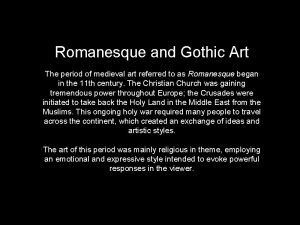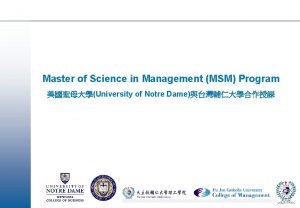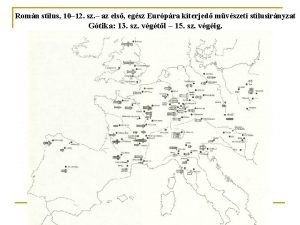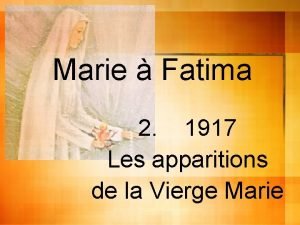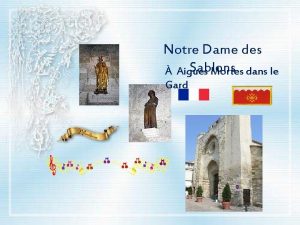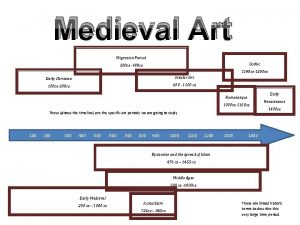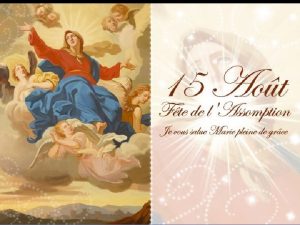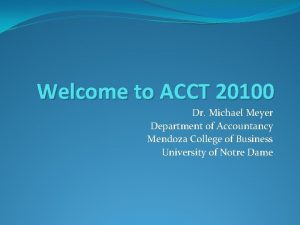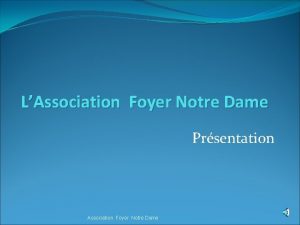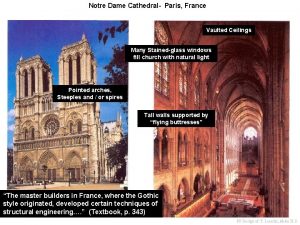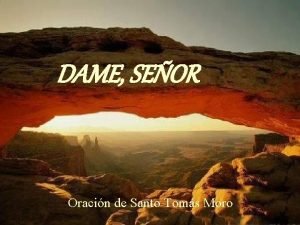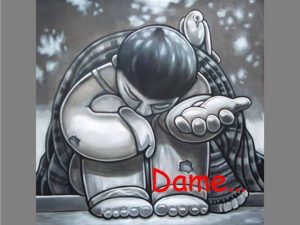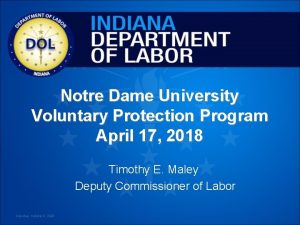France to Vincennes to Notre Dame The Congregation
















![Black Oak Ridge cabins Montgomery farm road St. Peter’s Church [today] October 13, 1841 Black Oak Ridge cabins Montgomery farm road St. Peter’s Church [today] October 13, 1841](https://slidetodoc.com/presentation_image_h/8c0f444ede7f538777ca7ead1d612f29/image-17.jpg)





- Slides: 22

France to Vincennes to Notre Dame The Congregation of Holy Cross arrived from France in September, 1841. This is the story of their first year, 175 years ago, and their eventual settlement along the St. Joseph River in Northern Indiana and the founding of the University of Notre Dame. It is a chronological look with photos, diagrams, and captions to explain the route and experiences of the “Seven Founders. ” [Prepared by Brother Larry Stewart, CSC, Midwest Province Archivist]

France to Vincennes to Notre Dame Father Basil Moreau Bishop Celestine Hailandiere Father Edward Sorin August 1839 --- Bishop Hailandiere of Vincennes, Indiana, traveled to France and met Father Moreau in Le Mans, seeking “teaching Brothers” for his schools. His request could not be answered or fulfilled at that time.

Notre Dame de Sainte Croix August 5, 1841 – the “First Colony” of Holy Cross religious to America consisted of three teachers (Vincent, Anselm, Gatian), a farmer (Lawrence), a tailor (Joachim), a carpenter (Francis Xavier), and a chaplain/superior (Father Sorin). They celebrated a departure ceremony at Le Mans and traveled to the harbor at Le Havre.

August 8, 1841 -- They boarded the sailing ship, Iowa, to set sails for America, but spent eight days in the calm English Channel when the sailing winds failed.

September 13, 1841 – The Iowa sailed into New York harbor (after a 35 -day trip)

New York City Scene - 1800 s St. Peter’s Catholic Church on Barclay St. September 14, 1841 -- Father Sorin celebrated his first Mass in America (feast of the Exaltation of the Holy Cross) in St. Peter’s Church in New York, but the Brothers had not been processed and could not leave the ship until the next day.

September 16, 1841 -- The group left New York City in a paddle boat up the Hudson River to Albany, where they transferred to the Erie Canal flatboats, pulled by horses, and headed west (350 miles) towards Buffalo.


September 24, 1841 -- When the canal boat arrived in Buffalo, Father Sorin and Brother Vincent rejoined the group since they had been visiting Niagara Falls for a day.

Maumee River and Toledo at Lake Erie September 25, 1841 – They left Buffalo aboard a Lake Erie steamer bound for Toledo (250 miles away). Strong waves caused the boat to put into port for 8 hours until the seas became calm

September 28, 1841 – They arrived in Toledo and learned the Miami Canal was not completed to Fort Wayne. They took a steamboat up the Maumee River towards Napoleon where they were forced to travel on land. They hired wagons and horses to carry their baggage. The muddy trails were in terrible condition.

October 1, 1841 -- They arrived in Fort Wayne, the first town within the Vincennes diocese. After staying the night, they continued their journey in flatboats on the Wabash River.

October 3, 1841 – They reached Logansport and were met by Father Martin, the Vicar General, who knew both Father Moreau and Father Dujarie. The group stayed with him for 2 days, then he led them to Lafayette.

October 5, 1841 – They left Lafayette having found a riverboat which would take them down the Wabash River towards Terre Haute (they arrived there on October 7).

October 10, 1841 – They finally reached Vincennes (having traveled for 67 days since leaving Le Mans) where they saw the tower of the new Cathedral at sunrise. They were welcomed and hosted by Bishop Hailandiere.

October 11, 1841 – Bishop Hailandiere did not have a specific site arranged for the group, but planned to give them a “choice. ” The Bishop took Father Sorin on horseback to visit a possible home in St. Francisville, Illinois, south of Vincennes, but Sorin found it unsuitable for their needs and plans. The next day, Father Sorin accompanied Father Delaune (the out-going pastor) to Black Oak Ridge, 27 miles east of Vincennes. They reached St. Peter’s, a little frame Church and two log cabins. Sorin examined the area with its garden, plentiful wood in the forest, rich black soil and decided there was no need to look elsewhere for their new home. He sent word to the Brothers to come from Vincennes.
![Black Oak Ridge cabins Montgomery farm road St Peters Church today October 13 1841 Black Oak Ridge cabins Montgomery farm road St. Peter’s Church [today] October 13, 1841](https://slidetodoc.com/presentation_image_h/8c0f444ede7f538777ca7ead1d612f29/image-17.jpg)
Black Oak Ridge cabins Montgomery farm road St. Peter’s Church [today] October 13, 1841 – The remainder of the Colony reached the Black Oak Ridge region and the town of Montgomery, about 27 miles east of Vincennes. They entered St. Peter’s Church and sang the Te Deum and started working. Vincent, Gatian, and Anselm continued studying English. Timber was cut for firewood for the winter. Francis Xavier made beds out of hollow logs and began repairs in the cabins. Joachim prepared meals and helped Lawrence cut down trees. Five young boys came hoping to begin school. A candidate (Charles Rother) had arrived earlier and was waiting to join the Holy Cross Brothers. By the end of December there were four candidates and within a year a total of twelve young men had joined the community.

The Colony began work at St. Peter’s --- forest trees were cut to clear land; logs were used to build more cabins and repair others; Father Sorin visited mission churches and greeted families within a 5 -mile radius; gardens were prepared for planting crops in the spring; Vincent, Gatian and Anselm taught children in elementary schools.

The Colony’s Goals Build a boarding school -> to educate students Build a novitiate -> to train novices Disagreements (1) -- Bishop Hailandiere assumed he was the acting “head” of all within his diocese including the Holy Cross religious. (2) -- disputes arose over who was to pay for the Colony’s travel expenses from France and for materials already used in the development at St. Peter’s. (3) -- the Bishop assumed the authority to assign Brothers to teach in schools. (4) -- the Colony needed to raise funds to develop the novitiate and train novices. (5) -- Sorin planned to build a college (a boarding high school). The Bishop objected since there already was a college in Vincennes run by the Eudists’ community. (6) -- the Bishop offered 524 acres of land if the Colony moved north and built a novitiate and college within two years. Fr Sorin put the decision to the Brothers, (once called the Brothers of St. Joseph) who thought moving to the “St. Joseph River” was providential.

From St. Peter’s to Notre Dame -- # 1 November 16 -27, 1842 Father Sorin, selected Brothers Francis Xavier, Gatian, and 5 novices to load horses, oxen, and wagons and they departed in bitter cold weather, leaving the other 11 Brothers at St. Peter’s to come in the spring. They made only 5 miles the first day. Sorin decided to split the group and took 4 Brothers and wagons with him, leaving 3 Brothers to bring the slower moving oxen and large wagon. They traveled the Wabash valley making it to Terre Haute in four days. They continued along the river bank to Lafayette and Logansport, where they traveled due north to reach South Bend on November 27 th after about 250 miles. The oxen and large wagon arrived a few days later. The travelers were hosted by friends and were elated to finally see their new home which was previously known as Saint Mary of the Lakes, (“Sainte-Marie-des-Lacs”) but now officially, Notre Dame du Lac.

From St. Peter’s to Notre Dame -- # 2 February 13 -27, 1843 Those remaining at St. Peter’s, (Brothers Vincent, Lawrence, Joachim, six novices and two postulants), prepared to depart in February. Anselm stayed to continue teaching at the school in Vincennes. The frigid cold winds and deep snows were worse than what the first group endured. Ice was a special problem for the four horses and eight oxen until their feet were re-shod. Lawrence had built a very large wagon to carry beds, provisions, four large trunks, kitchen materials, totaling over 3000 pounds. They followed the same route north the first group had traveled with the men taking turns walking and riding. An accident occurred when one of the large wagon wheels broke. They were able to obtain a large sled and put the wagon on it so they could now move more swiftly as it slid over the snow. One Brother wrote: “When we reached Notre Dame du Lac (on Feb 27, 1843) we were surprised at the beauty of the place. It was a joy to reunite with our community”

arrival Nov 27, 1842 renovated original Log Chapel - 1843 first building: Old College - 1843 The Colony immediately got to work at Notre Dame du Lac When Fr Sorin and the four Brothers arrived, they found a very old log church and a small cabin, both said to be “rude structures in wretched conditions” and not suitable to reside for the night. Repair work would be done to make them usable. Eventually the three Brothers and wagon arrived with all the loaded materials. The first task was to renovate the Log Chapel and start constructing their permanent dwelling. The second group from St. Peter’s arrived on February 27, 1843. Work proceeded so that the new Log Chapel was dedicated on the feast of St. Joseph, March 19 th. Father Sorin’s enthusiasm to start the ‘college’ involved getting his architect-builder friend to design and erect a four-story college building in 1843. But financial delays and insufficient materials postponed plans until 1844 when the first building was completed for the future University of Notre Dame du Lac.
 Romanesque art
Romanesque art Uss vincennes case study
Uss vincennes case study 1300 notre dame
1300 notre dame Nd army rotc
Nd army rotc Notre dame leeds moodle
Notre dame leeds moodle Notre dame msm program
Notre dame msm program Collège notre dame guingamp
Collège notre dame guingamp Brad weldon notre dame
Brad weldon notre dame Notre dame sorin society
Notre dame sorin society Ron kraemer notre dame
Ron kraemer notre dame Notre dame golden ratio
Notre dame golden ratio University of notre dame map
University of notre dame map Cathédrale notre-dame-de-l'assomption de naples
Cathédrale notre-dame-de-l'assomption de naples Enguerrand charonton
Enguerrand charonton Fatima 2
Fatima 2 Notre dame high school belmont
Notre dame high school belmont Notre dame des sablons
Notre dame des sablons Danny chen notre dame
Danny chen notre dame Insular art is art produced between 300 and 900 ce
Insular art is art produced between 300 and 900 ce Coca-cola sponsorship proposal
Coca-cola sponsorship proposal Notre dame army rotc
Notre dame army rotc Marie vierge sainte que drape le soleil
Marie vierge sainte que drape le soleil Acct20100
Acct20100
